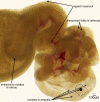Rethinking the relationship between hyperactivation and chemotaxis in mammalian sperm
- PMID: 20463353
- PMCID: PMC2957157
- DOI: 10.1095/biolreprod.109.083113
Rethinking the relationship between hyperactivation and chemotaxis in mammalian sperm
Abstract
Hyperactivation, a motility pattern of mammalian sperm in the oviduct, is essential to fertilization. Hyperactivation helps sperm to swim effectively through oviductal mucus, to escape from the sperm reservoir, and to penetrate the cumulus matrix and zona pellucida of the oocyte. There is some evidence that mammalian sperm can undergo chemotaxis; however, the relationship of chemotaxis to hyperactivation is unknown. Ca(2+) signaling is involved in hyperactivation and implicated in chemotaxis as well. In vivo, sperm hyperactivate in the lower oviduct, far from the cumulus-oocyte complex and possibly beyond the influence of chemotactic gradients emanating from the oocyte or cumulus. Thus, sperm are likely to be hyperactivated before sensing chemotactic gradients. Chemotactic signals might modulate hyperactivation to direct sperm toward oocytes as they reach a region of influence. Ca(2+)-directed modulation of hyperactivation is a potential mechanism of this process.
Figures




References
-
- Yanagimachi R.The movement of golden hamster spermatozoa before and after capacitation. J Reprod Fertil 1970; 23: 193–196. - PubMed
-
- Kaupp UB, Kashikar ND, Weyand I.Mechanisms of sperm chemotaxis. Annu Rev Physiol 2008; 70: 93–117. - PubMed
-
- Schwartz R, Brooks W, Zinsser HH.Evidence of chemotaxis as a factor in sperm motility. Fertil Steril 1958; 9: 300–308. - PubMed
-
- Dickmann Z.Chemotaxis of rabbit spermatozoa. J Exp Biol 1963; 40: 1–5. - PubMed
-
- Villanueva-Diaz C, Vadillo-Ortega F, Kably-Ambe A, Diaz-Perez MA, Krivitzky SK.Evidence that human follicular fluid contains a chemoattractant for spermatozoa. Fertil Steril 1990; 54: 1180–1182. - PubMed
Publication types
MeSH terms
Substances
Grants and funding
LinkOut - more resources
Full Text Sources
Miscellaneous

